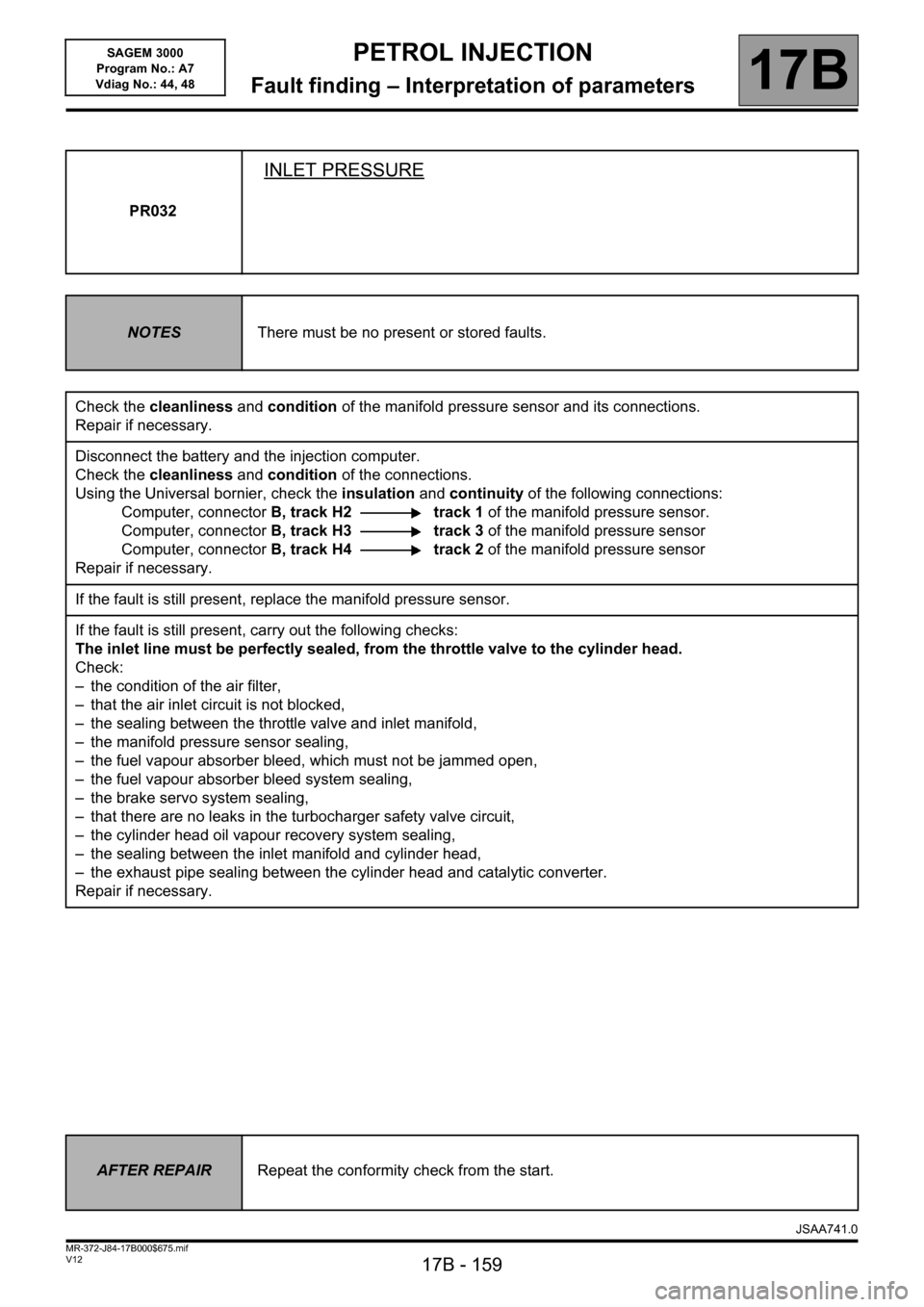2014 RENAULT SCENIC sensor
[x] Cancel search: sensorPage 138 of 181

PETROL INJECTION
Fault finding – Interpretation of statuses17B
17B - 138V12 MR-372-J84-17B000$540.mif
SAGEM 3000
Program No.: A7
Vdiag No.: 44, 48
ET052
UPSTREAM O2 SENSOR
NOTESThere must be no present or stored faults.
Check the cleanliness and condition of the upstream oxygen sensor and its connections.
Repair if necessary.
With the ignition on, check for + 12 V on track A of the upstream oxygen sensor connector.
If +12V is not present:
– disconnect the battery,
– disconnect the connector marked PPM1 from the Protection and Switching Unit,
– check the cleanliness and condition of the connections,
– using the Universal bornier, check the continuity on the following connection:
Protection and Switching Unit track 2 connector PPM1 track A of the upstream oxygen sensor
Reconnect the Protection and Switching Unit connector and reconnect the battery.
With the ignition on, if there is still no +12V at the upstream oxygen sensor connector, there is a fault in the
Protection and Switching Unit.
Contact the Techline.
Disconnect the battery and the injection computer.
Check the cleanliness and condition of the connections.
Using the universal bornier, check for insulation and continuity on the following connection:
Injection computer, connectorC, track L2 track B of the upstream oxygen sensor
Repair if necessary.
Measure the heating resistance between tracks A and B of the upstream oxygen sensor.
Replace the upstream oxygen sensor if the resistance is not approximately 9 at 20 °C.
If the fault is still present, replace the upstream oxygen sensor.
AFTER REPAIRRepeat the conformity check from the start.
JSAA741.0
Page 139 of 181

PETROL INJECTION
Fault finding – Interpretation of statuses17B
17B - 139V12 MR-372-J84-17B000$540.mif
SAGEM 3000
Program No.: A7
Vdiag No.: 44, 48
ET053
DOWNSTREAM O2 SENSOR HEATING
NOTESThere must be no present or stored faults.
Check the cleanliness and condition of the downstream oxygen sensor and its connections.
Repair if necessary.
Check for the + 12 V feed on track A, downstream oxygen sensor connector with the ignition on.
If +12V is not present:
– disconnect the battery,
– disconnect the connector marked PPM1 in the Protection and Switching Unit,
–check the cleanliness and condition of the connections,
– using the Universal bornier, check for continuity on the following connection:
Protection and Switching Unit track 2 connector PPM1 track A of the downstream oxygen sensor
Reconnect the Protection and Switching Unit connector and reconnect the battery.
With the ignition on, if the +12V is still not present on the downstream oxygen sensor connector, there is a fault
in the Protection and Switching Unit.
Contact the Techline.
Disconnect the battery and the injection computer.
Check the cleanliness and condition of the connections.
Using the universal bornier, check for insulation and continuity on the following connection:
Injection computer, connectorC, track L3 track B of the downstream oxygen sensor
Repair if necessary.
Measure the heating resistance between tracks A and B of the downstream oxygen sensor.
Replace the downstream oxygen sensor if the resistance is not approximately 9 at 20 °C.
If the fault is still present, replace the downstream oxygen sensor.
AFTER REPAIRRepeat the conformity check from the start.
JSAA741.0
Page 141 of 181

PETROL INJECTION
Fault finding – Interpretation of statuses17B
17B - 141V12 MR-372-J84-17B000$540.mif
SAGEM 3000
Program No.: A7
Vdiag No.: 44, 48
ET054
CONTINUED
IDLING SPEED
TOO HIGH
Check:
– the engine oil level (too high oil combustion),
– that the restrictions are present in the oil vapour rebreathing circuit,
– the sealing between the throttle valve and inlet manifold,
– the manifold pressure sensor sealing,
– the fuel vapour absorber bleed, which must not be jammed open,
– the fuel vapour absorber bleed system sealing,
– the brake servo system sealing,
– the sealing between the inlet manifold and cylinder head,
– the oil vapour recovery circuit sealing between the inlet manifold and cylinder head,
– the fuel pressure and flow (see MR 364 Mechanics, 17B, Petrol injection),
– the condition and cleanliness of the injectors,
– the cylinder compression's,
– the timing adjustment,
– the hydraulic tappets if there is camshaft noise (see MR 364 Mechanics, 11A, Top and front of engine).
Repair the defective component if necessary.
AFTER REPAIRRepeat the conformity check from the start.
JSAA741.0
Page 142 of 181

PETROL INJECTION
Fault finding – Interpretation of statuses17B
17B - 142V12 MR-372-J84-17B000$540.mif
SAGEM 3000
Program No.: A7
Vdiag No.: 44, 48
ET055
UPSTREAM SENSOR RICHNESS LOOP
NOTESThere must be no present or stored faults.
Check the cleanliness and condition of the upstream oxygen sensor connections.
Repair if necessary.
With the ignition on, check for + 12 V on track A of the upstream oxygen sensor connector.
If +12V is not present:
– disconnect the battery,
– disconnect the connector marked PPM1 in the Protection and Switching Unit,
– check the cleanliness and condition of the connections,
– using the Universal bornier, check for continuity on the following connection:
Protection and Switching Unit track 2 connector PPM1 track A of the upstream oxygen sensor
Reconnect the Protection and Switching Unit connector and reconnect the battery.
With the ignition on, if there is still no +12V at the upstream oxygen sensor connector, there is a fault in the
Protection and Switching Unit.
Contact the Techline.
Disconnect the battery and the injection computer.
Check the cleanliness and condition of the connections.
Using the universal bornier, check the insulation and continuity on the following connections:
Injection computer connectorC, track C1 track D of the upstream oxygen sensor
Injection computer, connectorC, track B1 track C of the upstream oxygen sensor
Injection computer, connectorC, track L2 track B of the upstream oxygen sensor
Repair if necessary.
Measure the heating resistance between tracks A and B of the upstream oxygen sensor.
Replace the upstream oxygen sensor if the resistance is not approximately 9 at 20 °C.
Check the condition and secure fitting of the upstream oxygen sensor.
If the vehicle is driven frequently in town, carry out a decoking procedure.
JSAA741.0
Page 143 of 181

PETROL INJECTION
Fault finding – Interpretation of statuses17B
17B - 143V12 MR-372-J84-17B000$540.mif
SAGEM 3000
Program No.: A7
Vdiag No.: 44, 48
ET055
CONTINUED
Check:
– the condition of the air filter,
– that the air inlet circuit is not blocked,
– the condition and conformity of the spark plugs,
– the sealing between the throttle valve and inlet manifold,
– the manifold pressure sensor sealing,
– the fuel vapour absorber bleed, which must not be jammed open,
– the fuel vapour absorber bleed system sealing,
– the brake servo system sealing,
– the turbocharger safety valve circuit sealing,
– the cylinder head oil vapour recovery system sealing,
– the sealing between the inlet manifold and cylinder head,
– the exhaust pipe sealing between the cylinder head and catalytic converter.
– the fuel flow rate and pressure.
If the idling speed is not stable, check:
– the timing adjustment,
– the hydraulic tappets if there is camshaft noise (seeMR 364 Mechanical, 11A, Top and front of engine),
– the cylinder compression's.
Drive the vehicle to check the repair.
Repair the defective components.
AFTER REPAIRRepeat the conformity check from the start.
JSAA741.0
Page 144 of 181

PETROL INJECTION
Fault finding – Interpretation of statuses17B
17B - 144V12 MR-372-J84-17B000$540.mif
SAGEM 3000
Program No.: A7
Vdiag No.: 44, 48
ET062
FLYWHEEL SIGNAL
NOTESThere must be no present or stored faults.
Information:
If the flywheel has been replaced or removed, reinitialise the flywheel target
programming.
Check the mounting and positioning of the TDC sensor (see MR 364 Mechanics, 10A, Engine and
peripherals).
Repair if necessary.
Check the cleanliness and condition of the TDC sensor and its connections.
Check the condition of the wire.
Repair if necessary.
Disconnect the battery and the injection computer.
Check the cleanliness and condition of the connections.
Using the universal bornier, check the insulation and continuity on the following connections:
Injection computer, connectorB, track E4 Track 2 of the TDC sensor
Injection computer, connectorB, track F3 track 1 of the TDC sensor
Repair if necessary.
Measure the resistance of the TDC sensor between tracks 1 and 2.
Replace the sensor if the resistance is not 200 to 270 at 23 °C.
If the sensor has been replaced, reset the flywheel signal programming.
Flywheel signal programming reinitialisation procedure:
Accelerate up to 4000 rpm in third gear ratio, then decelerate to power take-up speed*.
Then repeat immediately.
(* This is the moment when, during deceleration with no load, the engine drops to idle speed and recovers torque.)
If the fault is still present, check the cleanliness and condition of the flywheel.
AFTER REPAIRIf the TDC sensor has been replaced, reinitialise the programming (RZ005).
Repeat the conformity check from the start.
JSAA741.0
Page 156 of 181

PETROL INJECTION
Fault finding – Parameter summary table17B
17B - 156V12 MR-372-J84-17B000$630.mif
SAGEM 3000
Program No.: A7
Vdiag No.: 44, 48PETROL INJECTION
Fault finding – Parameter summary table
*OCR: Opening cycle ratioTool parameter Diagnostic tool title
PR001Advance
PR010Idle speed regulation setpoint
PR014Idling speed correction
PR015Engine torque
PR018Estimated air flow
PR028Pedal position (gang 1)
PR029Pedal position (gang 2)
PR030Accelerator pedal position
PR032Inlet pressure
PR035Atmospheric pressure
PR037Refrigerant pressure
PR041Turbocharging pressure
PR055Engine speed
PR058Air temperature
PR064Coolant temperature
PR071Computer feed voltage
PR089Vehicle speed
PR090Idle speed regulation programming value
PR091Theoretical idle speed regulation OCR
PR095Anti-pinking correction
PR096Motorised throttle upper stop programmed value.
PR097Motorised throttle lower stop programmed value.
PR098Upstream oxygen sensor voltage
PR099Downstream oxygen sensor voltage
PR100Torque lapse
PR101Duration of injection
PR102Canister bleed solenoid valve OCR*
JSAA741.0
MR-372-J84-17B000$630.mif
Page 159 of 181

PETROL INJECTION
Fault finding – Interpretation of parameters17B
17B - 159V12 MR-372-J84-17B000$675.mif
SAGEM 3000
Program No.: A7
Vdiag No.: 44, 48
PR032
INLET PRESSURE
NOTESThere must be no present or stored faults.
Check the cleanliness and condition of the manifold pressure sensor and its connections.
Repair if necessary.
Disconnect the battery and the injection computer.
Check the cleanliness and condition of the connections.
Using the Universal bornier, check the insulation and continuity of the following connections:
Computer, connectorB, track H2 track 1 of the manifold pressure sensor.
Computer, connectorB, track H3 track 3 of the manifold pressure sensor
Computer, connectorB, track H4 track 2 of the manifold pressure sensor
Repair if necessary.
If the fault is still present, replace the manifold pressure sensor.
If the fault is still present, carry out the following checks:
The inlet line must be perfectly sealed, from the throttle valve to the cylinder head.
Check:
– the condition of the air filter,
– that the air inlet circuit is not blocked,
– the sealing between the throttle valve and inlet manifold,
– the manifold pressure sensor sealing,
– the fuel vapour absorber bleed, which must not be jammed open,
– the fuel vapour absorber bleed system sealing,
– the brake servo system sealing,
– that there are no leaks in the turbocharger safety valve circuit,
– the cylinder head oil vapour recovery system sealing,
– the sealing between the inlet manifold and cylinder head,
– the exhaust pipe sealing between the cylinder head and catalytic converter.
Repair if necessary.
AFTER REPAIRRepeat the conformity check from the start.
JSAA741.0